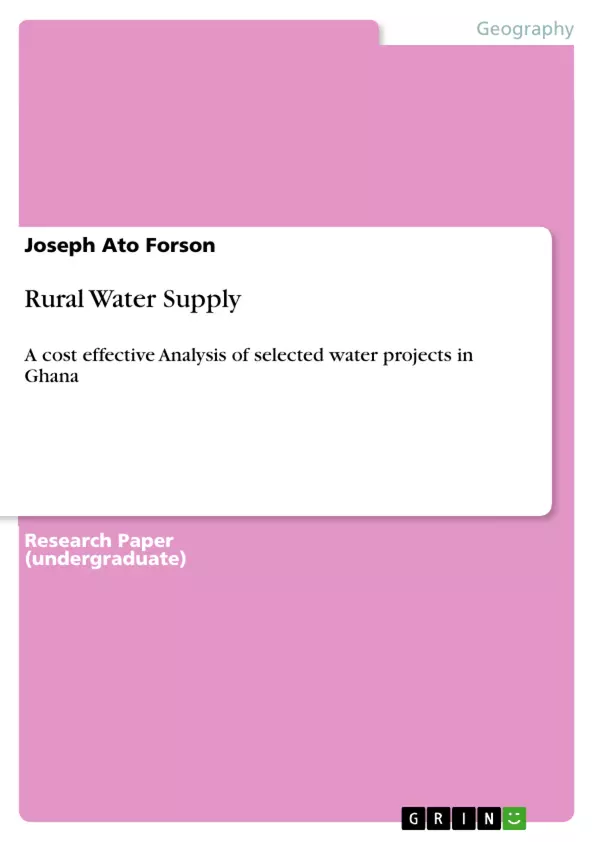The axiom “water is life and life is water” underscores the importance of water to the everyday needs of all living things including man. The global perspective on access to safe drinking water for both domestic and agriculture needs has for some time now been a major challenge. The WHO estimates that nearly 3.4 million people die annually as a result of water and sanitation related diseases and about 99 percent of this number is from developing countries. About 780 million people lack access to potable drinking water that is one in every nine people. Women spend almost 200 million hours daily collecting water for domestic chores. These findings are jaw-dropping. Ghana, as a developing country with an estimated population of 23 million is faced with these same challenges. Incidence of water related diseases have been prevalent in most rural communities in Ghana. Background check shows that Ghana’s problem in rural water supply have come as a result of low investments couple with high capital demands in carrying out annual rehabilitation works on existing facilities.
Inhaltsverzeichnis (Table of Contents)
- Executive Summary
- Acknowledgement
- SECTION ONE
- 1.0 BACKGROUND
- 1.1. Present state of rural water supplies in Ghana
- 1.1.1 Number of New communities/small towns pipes
- 1.1.2 Rehabilitation of water facilities.
- 1.1.3 Regional Water coverage at end-2006..
- 1.2 Climate
- 1.3 Geology
- 1.4 Snapshot of the National Community Water and Sanitation Agency in Ghana
- SECTION TWO
- 2.0 LITERATURE REVIEW
- 2.1 The Search for Interventions
- 2.2 Alternative sources of water.
- 2.2.2 Desalination...
- 2.2.3 Borehole/ Hand Dug Well..
- 2.3 Wrap-up of literature reviewed
- SECTION THREE
- 3.0 Policy Goal..
- 3.1 The research questions for this policy proposal..
- 3.2 Objectives of the Policy.
- 3.3 Policy alternatives
- 3.4 Scope and Methodology.
- 3.5 Limitations.
- 3.6 How to Measure.
- 3.7 Type of Analysis
Zielsetzung und Themenschwerpunkte (Objectives and Key Themes)
This policy proposal aims to address the challenges of water supply in rural Ghana by increasing rural water access. The goal is to increase the water coverage rate from 52.16% to 76% in rural communities. To achieve this, the proposal explores two policy alternatives: rain harvesting systems and desalination plants, alongside the existing government intervention (status quo). The cost associated with each intervention is estimated and projected to cover the duration of the proposed policy periods.- The challenges of water supply in rural Ghana.
- Cost-effective water supply interventions.
- Analysis of alternative water supply technologies.
- The role of government intervention in water supply.
- The importance of cost-effectiveness in rural water supply projects.
Zusammenfassung der Kapitel (Chapter Summaries)
The document begins with an overview of the challenges faced by rural Ghana in accessing safe drinking water, highlighting the prevalence of water-related diseases and the global context of water scarcity. The first chapter then provides a detailed analysis of the current state of rural water supply in Ghana, outlining the number of new communities with access to piped water, rehabilitation efforts, and regional water coverage. It also discusses the climatic and geological factors affecting water availability. The second chapter reviews existing literature on interventions for improving water access, exploring alternative sources of water such as desalination and borehole/hand-dug wells. It examines the pros and cons of each option and discusses the factors that contribute to successful implementation. The third chapter lays out the policy goal, research questions, objectives, alternatives, and methodology of the proposal. It defines the scope and limitations of the research and outlines the methods used to analyze and measure the effectiveness of the proposed interventions. The fourth chapter analyzes the cost-effectiveness of three policy alternatives: borehole projects, rain harvesting systems, and desalination plants. The chapter presents a detailed cost analysis of each option, taking into consideration the total annual cost, cost recovery factor, and per capita cost. It then determines the Cost Effectiveness Ratio (CER) for each intervention and identifies the most cost-effective option. The results of the sensitivity analyses are presented, highlighting the stability of the results under varying discount rates and project lifespans.Schlüsselwörter (Keywords)
This policy proposal focuses on the challenges of providing safe drinking water to rural communities in Ghana. Key keywords and concepts include: rural water supply, cost-effectiveness analysis, policy alternatives, rain harvesting systems, desalination plants, borehole projects, cost effectiveness ratio (CER), sensitivity analysis, and government intervention.- Arbeit zitieren
- PhD student Joseph Ato Forson (Autor:in), 2012, Rural Water Supply, München, GRIN Verlag, https://www.grin.com/document/207596



